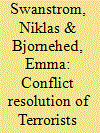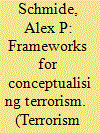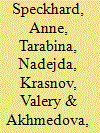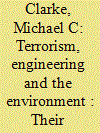| Srl | Item |
| 1 |
ID:
053771


|
|
|
|
|
| Publication |
Summer 2004.
|
| Summary/Abstract |
This article addresses the issue of transnational terrorism in Southeast Asia. The objective of the article is to investigate the structure of the transnational element of terrorism to determine their impact on conflict resolution attempts in the region. The transnational terrorist organization Jemaah Islamyiah will be used as a single case for the analysis. From this analysis, obstacles toward conflict resolution originating from the structure of transnational terrorism are identified, and the article provides suggestions on how to circumvent these impediments
|
|
|
|
|
|
|
|
|
|
|
|
|
|
|
|
| 2 |
ID:
066074


|
|
|
| 3 |
ID:
066073


|
|
|
| 4 |
ID:
053760


|
|
|
|
|
| Publication |
Summer 2004.
|
| Summary/Abstract |
This article tries to quantify empirically the factors behind terrorism in 37 Muslim countries. In the article’s most complete model, regressors include education attainment, political repression, income (GDP per capita), and a dummy for civil wars. We find education to be a positive determinant of terrorism— i.e., higher education levels give rise to more transnational terrorism in sample countries, low and high repression are a positive determinant of terrorism, so that a nonlinear relation (U-shaped) holds. The civil war dummy is also a positive influence. The income variable is a negative determinant of terrorism, but is either marginally significant or insignificant.
|
|
|
|
|
|
|
|
|
|
|
|
|
|
|
|
| 5 |
ID:
053747


|
|
|
|
|
| Publication |
Summer 2004.
|
| Summary/Abstract |
Terrorism has been situated—and thereby implicitly also defined—in various contexts such as crime, politics, war, propaganda and religion. Depending on which framework one chooses, certain aspects of terrorism get exposed while others are placed ‘outside the picture’ if only one framework is utilised. In this article five conceptual lenses are utilised: 1. terrorism as/and crime; 2. terrorism as/and politics; 3. terrorism as/and warfare; 4. terrorism as/and communication; and 5. terrorism as/and religious fundamentalism.
|
|
|
|
|
|
|
|
|
|
|
|
|
|
|
|
| 6 |
ID:
053763


|
|
|
|
|
| Publication |
Summer 2004.
|
| Summary/Abstract |
This article demonstrates the relationship between new social movement theory and terrorism studies. The revolutionary dimension of new social movements can be correlated to terrorist groups. This article also uses new social movement theory to develop a fuller understanding of the leadership, membership, personal ideology and gender within a new social movement; these then can be used to follow the development of a politically violent group. This article uses the example of the American movement and its by-product—the Weather Underground.
|
|
|
|
|
|
|
|
|
|
|
|
|
|
|
|
| 7 |
ID:
053768


|
|
|
|
|
| Publication |
Summer 2004.
|
| Summary/Abstract |
11 September woke the world up to the scourge of the twenty-first century—suicidal terrorism. Hostage-taking coupled with suicidal terrorism is its newest variant, played out in a Moscow theater in late October 2002. Forty Chechen terrorists armed with automatic rifles, grenades and self-detonating bombs announced to 800 plus hostages that the event was a suicide mission. The standoff ended when Russian Special Forces gassed and stormed the building, killing all the terrorists. Suicidal terrorists are rarely, if ever, observed in action. In the first months after the event, an American psychologist collaborated with Russian Academy of Sciences colleagues to collect interviews from the hostages. This article reports on hostages’ observations, interactions and conversations with the 40 suicidal terrorists.
|
|
|
|
|
|
|
|
|
|
|
|
|
|
|
|
| 8 |
ID:
053759


|
|
|
|
|
| Publication |
Summer 2004.
|
| Summary/Abstract |
The 11 September attacks cannot be understood fully without an understanding of the ideas of Sayyid Qutb, who is widely acknowledged as the intellectual godfather for the various modern radical Islamic movements, including Al-Qaeda. Qutb's writings are important because they define the core elements that have been adopted by all radical Islamic movements. These include: (1) an extreme hostility toward Western culture, especially the role of women and sexual mores in the West; (2) the formation of society under the rule of Sharia, Islamic law; (3) the overthrow of governments not under the rule of Sharia by means of holy war; and (4) an intense hatred of Jews and distrust of Christians. This article also illustrates Qutb's influence on radical Islamic groups.
|
|
|
|
|
|
|
|
|
|
|
|
|
|
|
|
| 9 |
ID:
053766


|
|
|
|
|
| Publication |
Summer 2004.
|
| Summary/Abstract |
The study of countering terrorism came to the fore following the terrorist attacks of 11 September 2001 in New York. The study has taken many paths. These include looking at the sociology/psychology of the terrorist or terrorist group, the understanding of terrorist organisations, the use of risk management techniques to identify targets that may be of interests to terrorists, the design of security infrastructure to counter or ward off terrorism and the consideration of how built infrastructure/environment may be strengthened to mitigate the effects of terrorism.
|
|
|
|
|
|
|
|
|
|
|
|
|
|
|
|